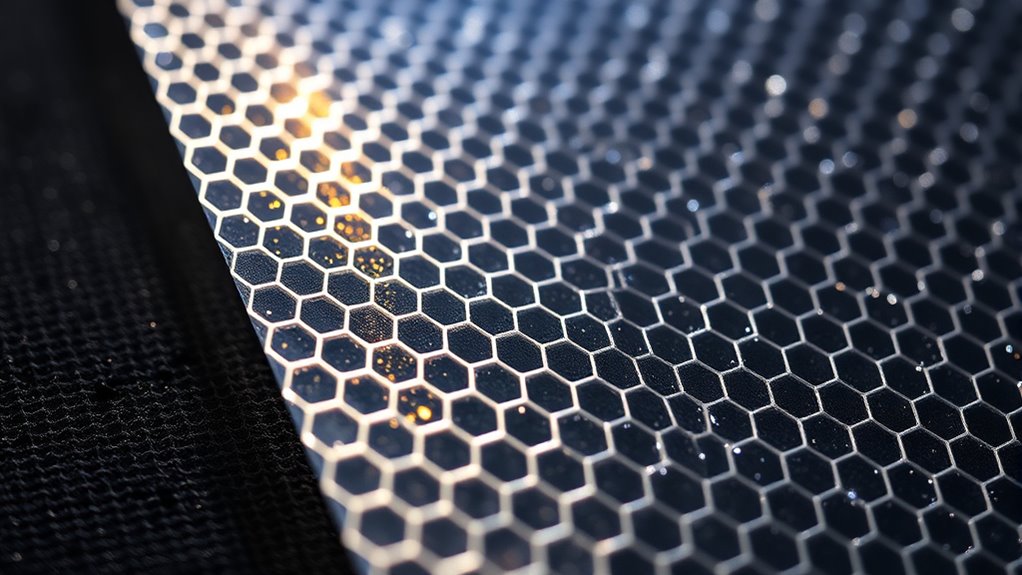Carbon nanomaterials like graphene, CNTs, and nanodots are remarkable due to their unique structures and exceptional properties. You’ll find graphene as a single-layer carbon sheet, CNTs as tiny cylinders, and nanodots as bright, surface-functionalized particles. They’re produced through methods like chemical vapor deposition and electrochemical synthesis, offering high electrical conductivity, strength, and tunable optical features. Exploring further reveals how these materials power innovations in electronics, energy, and medicine, opening new technological possibilities.
Key Takeaways
- Graphene is a single-atom-thick carbon layer with exceptional strength, electrical conductivity, and flexibility.
- Carbon nanotubes (CNTs) are cylindrical graphene derivatives exhibiting high tensile strength and excellent electrical and thermal properties.
- Carbon nanodots are small, surface-functionalized particles known for high solubility, fluorescence, and applications in bioimaging and sensing.
- Synthesis methods like CVD and electrochemical techniques enable controlled fabrication of these nanomaterials with tailored properties.
- Their unique optical, electrical, and mechanical features drive applications in electronics, energy storage, medicine, and advanced composites.
Structural and Chemical Properties of Graphene, CNTs, and Carbon Nanodots

Graphene, carbon nanotubes (CNTs), and carbon nanodots each exhibit unique structural and chemical properties that make them valuable in various applications. Graphene is a single layer of carbon atoms arranged in a hexagonal lattice, giving it exceptional strength, flexibility, and high electrical conductivity. CNTs are cylindrical structures formed by rolling graphene sheets, which provide remarkable tensile strength, electrical conductivity, and thermal stability. Carbon nanodots are tiny, quasi-spherical particles with abundant surface functional groups, making them highly soluble and chemically reactive. These nanomaterials often feature a high surface area-to-volume ratio, enhancing their reactivity and interaction with other substances. Their distinct structures and surface chemistries allow for tailored functionalities, making them suitable for electronics, sensors, energy storage, and biomedical applications. Additionally, the surface chemistry of these nanomaterials can be modified to improve their compatibility and performance in specific environments.
Synthesis and Fabrication Techniques for Carbon Nanomaterials

You can create carbon nanomaterials using techniques like Chemical Vapor Deposition and electrochemical synthesis, each offering unique advantages. Chemical Vapor Deposition allows for precise control over the material’s structure, while electrochemical methods are often simpler and more scalable. Understanding these methods helps you choose the right approach for your specific application. Additionally, high-quality fabrication is essential for achieving optimal performance in various applications.
Chemical Vapor Deposition
Have you ever wondered how carbon nanomaterials like graphene and carbon nanotubes are reliably produced at a large scale? Chemical Vapor Deposition (CVD) is a key technique. It involves introducing gaseous carbon sources, such as methane, into a reactor with a heated substrate. The gases decompose, depositing carbon atoms that form high-quality nanomaterials. CVD offers control over thickness, uniformity, and quality, making it ideal for scaling production. Here’s a quick overview: You can also optimize the growth process by adjusting parameters like temperature and gas flow to achieve the desired material properties, which are crucial for material quality and application performance.
| Technique Type | Temperature Range | Typical Carbon Source |
|---|---|---|
| Thermal CVD | 700-1000°C | Methane, Ethylene |
| Plasma-Enhanced CVD | 300-600°C | Acetylene |
| Atomic Layer CVD | 200-400°C | Carbon Precursors |
| Metal Catalyzed | Varies | Hydrocarbons |
| Low-Pressure CVD | 600-900°C | Various Gases |
Electrochemical Synthesis Methods
Electrochemical synthesis has emerged as a promising alternative for producing carbon nanomaterials due to its simplicity and environmental friendliness. In this method, you apply an electrical potential to drive reactions that deposit carbon onto electrodes, forming nanostructures like graphene or carbon dots. It allows precise control over parameters such as voltage, current density, and electrolyte composition, enabling tailored nanomaterial properties. You can perform electrochemical synthesis in aqueous or organic electrolytes, making it versatile and scalable. The process is energy-efficient and produces minimal waste compared to traditional methods. By adjusting conditions, you can influence the size, shape, and quality of the carbon nanostructures. This technique offers a rapid, cost-effective route to fabricate high-quality carbon nanomaterials for various applications.
Electrical Conductivity and Mechanical Strength in Nanomaterials

Nanomaterials often exhibit remarkable electrical conductivity and mechanical strength, making them highly valuable for advanced technological applications. You’ll find that graphene, for example, has exceptional electron mobility, allowing it to conduct electricity more efficiently than copper. Its strength surpasses steel by over 100 times, providing durability without added weight. Carbon nanotubes (CNTs) also excel in this area, offering high tensile strength and excellent electrical properties, making them ideal for flexible electronics and strong composite materials. Carbon nanodots, while less conductive, still display notable electrical behavior suited for sensing and bioimaging. These properties stem from their unique atomic arrangements and strong covalent bonds, which give nanomaterials their resilience and conductivity. Additionally, the preppy dog names reflect the sophisticated aesthetic of design, similar to the refined qualities seen in these nanomaterials. As a result, they open new possibilities in electronics, materials science, and energy storage.
Optical Characteristics and Photoluminescence Features

Understanding the photoluminescence mechanisms in carbon nanomaterials reveals how they emit light when energized. You can also explore strategies to tune their emission wavelengths for specific applications. This knowledge helps optimize their optical properties for use in sensors, displays, and bioimaging. Additionally, the water resistance features of certain nanomaterials enhance their performance in real-world environments.
Photoluminescence Mechanisms
Photoluminescence in carbon nanomaterials arises from their unique electronic structures, which enable them to absorb photons and re-emit light with distinctive optical features. In carbon nanodots, for example, the emission results from surface defect states and quantum confinement effects, creating energy levels that facilitate light emission. For graphene and carbon nanotubes, the mechanisms involve exciton formation and recombination, influenced by their band structures and electronic interactions. When you excite these materials with light, electrons are promoted to higher energy states. As they relax back to lower levels, photons are emitted. The specific emissions depend on factors like particle size, surface chemistry, and defect density. Additionally, photoluminescence mechanisms are affected by the presence of surface functional groups and structural defects, which modify energy transfer pathways. Understanding these mechanisms helps you tailor their optical properties for applications in bioimaging, sensors, and optoelectronics.
Wavelength Tuning Strategies
How can you effectively tune the wavelength of emitted light in carbon nanomaterials to suit specific applications? You can achieve this by manipulating their structural properties, such as size, shape, and surface chemistry. For example, in carbon dots, adjusting the synthesis conditions like temperature or precursor materials shifts their emission wavelengths. Doping with heteroatoms like nitrogen or sulfur introduces new energy states, enabling emission at different wavelengths. For carbon nanotubes, modifying their diameter and chirality alters their optical absorption and emission properties. Surface functionalization also plays a pivotal role, as it can enhance or suppress certain photoluminescence features. Additionally, understanding the structure-property relationship helps in designing nanomaterials with targeted optical characteristics. By combining these strategies, you can precisely control the emission spectrum, tailoring carbon nanomaterials for applications in bioimaging, sensors, and optoelectronic devices.
Current Applications in Electronics, Energy, and Medicine

Carbon nanomaterials have revolutionized various industries by enabling more efficient and innovative solutions in electronics, energy, and medicine. In electronics, they improve flexible displays, sensors, and transistors, leading to faster, smaller devices. For energy, they enhance battery capacity, supercapacitors, and solar cells, making energy storage more sustainable. In medicine, they enable targeted drug delivery, biosensors, and imaging techniques, improving diagnostics and treatments. These materials’ unique properties help you develop cutting-edge technologies across sectors. Here’s a quick comparison: compatibility factors.
| Application Area | Key Benefits |
|---|---|
| Electronics | Flexibility, high conductivity |
| Energy | Increased storage, lightweight design |
| Medicine | Targeted delivery, sensitive detection |
| Overall | Versatility, durability, biocompatibility |
Challenges and Limitations in Utilizing Carbon Nanomaterials

Despite their remarkable properties, integrating carbon nanomaterials into practical applications presents significant challenges. One major hurdle is scalable, cost-effective production, as methods like chemical vapor deposition or exfoliation often lack consistency and are expensive. Controlling material quality and uniformity remains difficult, which affects performance and reliability. Additionally, handling and processing nanomaterials pose safety concerns due to potential toxicity and environmental impact. Compatibility with existing manufacturing processes can also be problematic, requiring specialized equipment or conditions. Moreover, issues like aggregation and poor dispersibility hinder device integration. These limitations slow down commercial adoption and demand ongoing research to develop safer, more efficient production techniques, improve material stability, and address environmental and health concerns associated with widespread use of carbon nanomaterials. Advancements in synthesis methods are crucial for overcoming these barriers and enabling broader application.
Future Directions and Emerging Innovations

Advancements in fabrication techniques and material engineering are opening new avenues for carbon nanomaterials, addressing previous limitations. You can now develop more scalable, cost-effective methods to produce high-quality graphene, CNTs, and nanodots, accelerating commercial applications. Emerging innovations include hybrid materials that combine carbon nanostructures with other nanomaterials to enhance performance. Researchers are exploring functionalization strategies to improve biocompatibility and sensing capabilities. Quantum computing and energy storage are also benefiting from these advancements, enabling more efficient, durable devices. Additionally, environmental remediation technologies are leveraging carbon nanomaterials’ unique properties for pollution control. As these innovations mature, expect breakthroughs that will expand your ability to design tailored solutions across electronics, medicine, and sustainable technologies, making carbon nanomaterials integral to future scientific and industrial progress. Unique and Wicked Planters
Frequently Asked Questions
How Do Environmental Factors Affect the Stability of Carbon Nanomaterials?
Environmental factors like temperature, humidity, and exposure to chemicals can substantially impact the stability of carbon nanomaterials. You might notice that high temperatures cause oxidation or structural degradation, while moisture promotes corrosion or aggregation. Chemical exposure, such as acids or bases, can alter their surface chemistry, reducing functionality. To maintain their stability, you should control environmental conditions, apply protective coatings, and handle them with care to prevent deterioration over time.
What Are the Most Cost-Effective Methods for Large-Scale Production?
If you think high-tech nanomaterials come with a hefty price tag, think again. You can save costs by using chemical vapor deposition, arc discharge, or simplified exfoliation methods. These techniques are surprisingly affordable for large-scale production, especially when you optimize parameters and minimize waste. So, while it seems complex, scaling up doesn’t have to drain your budget—just choose the right method and keep it simple.
How Do Carbon Nanomaterials Interact With Biological Systems?
You should know that carbon nanomaterials interact with biological systems mainly through cellular uptake, membrane interactions, and protein binding. They can enter cells via endocytosis or diffusion, affecting cell functions. Their surface properties influence biocompatibility and toxicity, enabling uses in drug delivery, imaging, and biosensing. However, you need to carefully consider their potential health risks, as their interactions can cause oxidative stress or inflammation in biological tissues.
Are There Any Safety Concerns Associated With Their Use?
Yes, there are safety concerns you should consider. You might encounter toxicity risks if these nanomaterials penetrate cells or tissues, potentially causing inflammation or oxidative stress. Inhalation or skin exposure could pose health hazards, especially with poorly controlled handling. It is crucial to follow safety guidelines, use protective equipment, and conduct thorough risk assessments to minimize potential adverse effects when working with carbon nanomaterials.
What Are the Recyclability and Disposal Options for Carbon Nanomaterials?
Imagine you’re a pioneer in nanotech, charting the future. You can recycle carbon nanomaterials by chemical or thermal methods, breaking them down for reuse or safe disposal. You should handle them with care, as some can be environmentally persistent or toxic. Disposal options include specialized waste management facilities, ensuring they don’t harm ecosystems. Always follow regulations and consider environmentally friendly approaches to minimize impact when recycling or disposing of these materials.
Conclusion
You now know how carbon nanomaterials like graphene, CNTs, and nanodots are revolutionizing tech with their unique properties. Did you know that graphene is 200 times stronger than steel yet incredibly lightweight? As research advances, expect these materials to transform electronics, energy storage, and medicine. Stay excited—these innovations could soon change your everyday life, making devices faster, greener, and more efficient than ever before.









